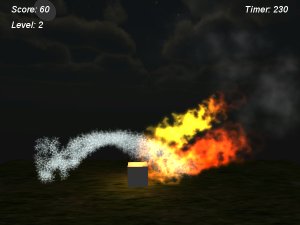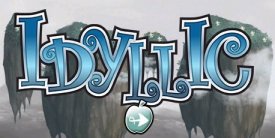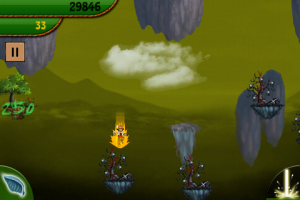 Tell us a little about the people behind the FatCow Games logo. How big is the team currently, and are the FatCow projects everyone’s first experiences in videogame development?
Tell us a little about the people behind the FatCow Games logo. How big is the team currently, and are the FatCow projects everyone’s first experiences in videogame development?
Well, it has been ups and downs, really. We were originally called something else and we were many more when we first started the journey, but only a handful remain on the battlefield. We believe this is the first experience for everyone, doing a full videogame development from scratch to release, except Amit Ginni, who has previous experience at another studio with a game under his belt already.
What role have partnerships with fellow indie developers played in FatCow’s creative philosophy and business model? What would you expect a potential partner to have ready before approaching you – design documents, sample art resources, a funding plan, etc.?
Partnerships play a vital role in our philosophy and business model. We believe cooperating is the key to success and if you are in it with us, you are in it 5050 in terms of release content, patches, expansion and everything. Partners will be treated as an extension of our studio or even internal staff; you have to learn this mindset in Norway if you want to survive in the game industry. They will also have a key position and role from design to development to release and so on. We can normally provide design documents, sample art resources, a funding and marketing plan, and most design. The prospective partner might provide additional programming, backup design, and graphics and basic quality assurance.
But while it is great to have “design documents, sample art resources and a funding plan,” the single most important thing to have is the belief and drive for that idea. If the partner can see the product of their dream and be able to convey that dream to us and get us just as excited, then there is a possible partnership. Of course there has to be some kind of proof to back up this dream. Draw up the project plan. Put down every detail possible. You obviously can’t know everything that will happen during the development cycle but you should have a pretty good idea what it will take to get your dream from inside your head onto paper, into tasks assigned to individuals that can complete those tasks. So simply put, have the drive, do the research, and go for it.
 Suffice it to say that FatCow has embraced Unity3D. What about this engine makes it most attractive for your projects, either from a technical perspective or resources available to Unity3D developers?
Suffice it to say that FatCow has embraced Unity3D. What about this engine makes it most attractive for your projects, either from a technical perspective or resources available to Unity3D developers?
Honestly, not everyone was attracted to it, not at first anyway. Some had their share of the “Ultimate Game Engines” between dealing with the hassle of importing models and missing pieces of functionality from other engines we were ready to roll with. But we gave it a try so we could write down all the things we can’t stand. Then a funny thing happened, we actually started to enjoy making the game with an engine we had just started touching. The fact that we could drag and drop a simple C# script or JavaScript script and then hit play, and see it running right away, was just awesome. We then figured that this will probably have a very small user base or it has to be built for specific domains only. Then to find out that we can build for Windows, Mac, iPhone, Web, Nintendo and so on…we were immensely happy with that kind of portability.
Granted, some code has to be changed based on the platform, but when you consider that you can do this from the same editor and you don’t have to rebuild the project in a completely separate environment, it really helps speed up development time. The other nice thing is that even though you can make the game faster, you’re not suffering from a drop in quality. It looks very nice and you can easily import what you need to polish your game. So overall it is attractive because of rapid development, portability, and quality.
 The FatCow blog prominently features a number of game prototypes made with Unity3D. Have lessons drawn from these short exercises played any part in the development cycles of the team’s larger projects?
The FatCow blog prominently features a number of game prototypes made with Unity3D. Have lessons drawn from these short exercises played any part in the development cycles of the team’s larger projects?
Due to Unity3D’s ability to allow us to rapidly prototype functionality, we can think of an idea and try to implement it as a separate project. And then troubleshoot it until we get it to where we want. This way we are not breaking the core source code of the game, especially if we are currently QA’ing some functionality we just added. We can then add it to the game easily. Doing these prototypes also lets us start planning how long it would take per feature. If a basic feature takes an hour to create, then we can extrapolate how long it would roughly take for other features.
 Let’s move on to your upcoming iOS release, Idyllic. The game is still wrapped in something of a sense of mystery – what we know so far is that it’s got a gorgeous presentation and lots of platform jumping. What is the player’s goal, and will it be an exclusively single player experience?
Let’s move on to your upcoming iOS release, Idyllic. The game is still wrapped in something of a sense of mystery – what we know so far is that it’s got a gorgeous presentation and lots of platform jumping. What is the player’s goal, and will it be an exclusively single player experience?
Idyllic will become even better as people buy it and we can afford to invest more time and build upon the game, add more content, world, multiplayer and what not. The current goal is to simply jump as long as you can, collect coins, upgrade your powers, defeat monsters in your way, heal islands, observe the world go from dark corruption to its original beautiful state, listen to the music change from dark to fun sounding, and so on. A lot of work went into making custom graphics but there is a limit to how pretty we can make things. So once things are pretty you keep jumping in a “survival” mode. If enough people buy our game we might implement worlds and dimensions, which we already have sketches for.
 How long has Idyllic been in development? Did you always have iOS in mind for the platform, and will the game land on other platforms as well?
How long has Idyllic been in development? Did you always have iOS in mind for the platform, and will the game land on other platforms as well?
We think it has been 6 months now. The inspiration came back in 2009, when Amit Ginni pitched it to the studio he was working for and not much happened. In 2010, several studios traveled to South Korea and Japan to meet up with Sega, Nexon and so on, where he pitched it to someone at Art Plant. The person gave a reasonable response and Amit decided to follow through since it was time to FINISH a project and not just start them. The game will come out on iOS platforms and hopefully enough people will support us that we can launch it on other platforms over time, even consoles. If not, we start on a new project.
How will Idyllic’s movement controls work, exactly?
At the moment it is tilting and tapping the screen. The original design was a lot more innovative but it was very difficult for the team, so we will hopefully implement touch and drag gameplay for iPad in the future. It will happen sooner if all your readers buy our game, since that control requires a great deal of resources and change of gameplay elements.
 It’s pretty amazing to witness the character design evolution shown in the “Artistic Journey So Far” preview. How did the team decide when it was time to try something new and when a design was finally a perfect fit?
It’s pretty amazing to witness the character design evolution shown in the “Artistic Journey So Far” preview. How did the team decide when it was time to try something new and when a design was finally a perfect fit?
Just between you, us, and the readers, that is not all the characters! As for the team deciding when it was time…we didn’t. There have been several testers and community votes on this. So the potential customers have decided this. If it was up to Amit he would spend 10 years making up his mind, so he let the users decide for us.
What can you tell us about any other projects the FatCow team might be working on? Do you plan to continue developing for iOS?
We do have some other projects in the pool that are taking shape. When they have been properly designed and enough rough drafts have been thrown away and rewritten, we will announce it. As for iOS, we are not going anywhere. We plan to develop on this mobile platform and some others for a long time to come. As time goes on you will notice the strategy we are taking in terms of branding our company and becoming a familiar face everywhere.
iFanzine’s thanks goes to Amit Ginni & the FatCow crew for taking some time out of their busy development schedule to chat with us. No word on a release date for Idyllic quite yet, but you can keep an eye on FatCow’s website, Twitter feed, and Facebook page for the latest info. Let’s leave you with some recent beta footage!


